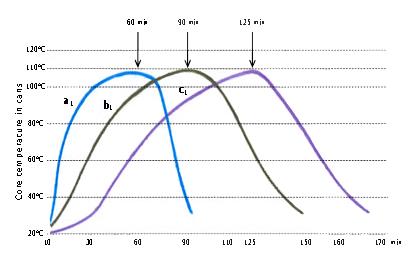Food safety measures are aimed at ensuring that the food that is canned has no microbiological contamination or toxins. The canning process can differ based on the food, container and contamination involved.
Food Safety Criteria
Vegetables, fruits, meat, fish, and dairy products can be contaminated by different bacteria, which can produce toxins that can sometimes even be fatal as in case of the Botulism caused by Clostridium botulinum if the canning process has not been thorough.
The European Food Safety Authority (EFSA) has developed food safety criteria based on internationally recognized scientific advice from the Codex Alimentarius. Food safety criteria specifies conditions required to make the bacteria in the food, such as Salmonella, Listeria monocytogenes, Enterobacter sakazakii, Campylobacter, and Clostridium etc., inactive, so that they cannot produce toxins and metabolites.
Sterilization is the process which creates the conditions where bacteria can no longer grow and remain active.
 Canning for Food Safety
Canning for Food Safety
The canning and sterilization process aims to produce healthy food that has a long and stable shelf life, and meets consumer preferences, by
- Making food, safe and free of microbial contamination.
- Limiting degradation of their sensory quality, that is their colour, appearance, texture, and taste.
- Preventing loss of nutritional value due to destruction of vitamins and proteins.
Sterilization can be done through either thermal or non-thermal processes.
Thermal Sterilization
Thermal sterilization is the commonly used process, and there are two methods, retorting and aseptic processing.
- Retort processing involves unsterilized, raw or cooked food that is filled in cans and hermetically sealed, and then subjected to thermal sterilization. It is therefore also called in-container sterilization. This is the traditional method that has been used for more than 200 years and is still popularly used for solid foods.
- Aseptic processing involves food, usually liquids, which are sterilized and then filled in sterilized containers under aseptic conditions. This is a modern method that was developed in the 1940s.
Thermal Process
In the thermal process, where cans and food are heated, retort processing where food is in cans needs a higher temperature for sterilization. Cans are heated rapidly to 130–145 °C through direct or indirect heating in autoclaves. Then the temperature is held for a specified period of time and then rapidly cooled.
The temperature and the duration of sterilization are important factors here. The higher the temperature used, the less is the sterilization time needed to kill the micro-organisms. The duration of sterilization needed to kill microbes is called ‘Fatal time’, and will also vary depending on the
- Material and dimensions of the metal packaging,
- Food being processed and,
- Type and number of contaminating microbes.
Type of Packaging
The size and type of metal container can influence the duration of the sterilization process, as bigger cans will contain more food. Moreover, depending on the shape, different durations of heating are required to successfully sterilize the centre of a can (called cold point), where heat reaches last. In the image below taken from Food Agriculture Organization, the same food content, meat, is packed in cans made of the same material. The cans have the same base area of 99mm, but different heights of 36, 63 and 113 mm. The taller cans need more time to be sterilized, as it takes longer for the cold point to get heated.

Image credits: FAO - Important note: these graphs show the behaviour of 3-piece-tins. Tins with 2 parts might behave completely differently.
Metal cans can be round, oval, elliptical and rectangular. Taking the different shapes and the different capacities, there are at least 60 different types of cans. As a result there is a wide range of sterilization regimes, just taking cans into consideration.
Non-Thermal Sterilization
There are many new techniques of non-thermal sterilizations that are being developed, like high pressure, electro-beam aseptic and microwave-assisted pasteurization. The most important non-thermal method widely used to sterilize food is high pressure.
High Pressure Sterilization
High pressure sterilization is a new technique that is being developed for liquids and solid foods, in response to consumer demand for better food aesthetics. It can be used for both retort and aseptic processing, where high pressures between 50 and 1000 MPa are applied to the food material to sterilize it, without any application of heat. The advantages are,
- Inactivation of microorganisms and enzymes,
- Preservation of colour, texture, taste, and nutrient content compared to heat sterilization, and
- Assistance in other food processing operations such as freezing
High pressure thermal sterilization (HPTS) is an innovation that has been developed in 2018, and uses both heat and high pressure, and offers all the advantages of high pressure sterilization. It is being considered for use in ready-to-heat-meals in metal packages.
Growing Field of Innovation
As the range of food, vegetables, fruits, meat, juice and dairy products that are canned increases and the shape of the packaging material changes, newer techniques and devices for sterilization are being developed to keep pace with market demand.






